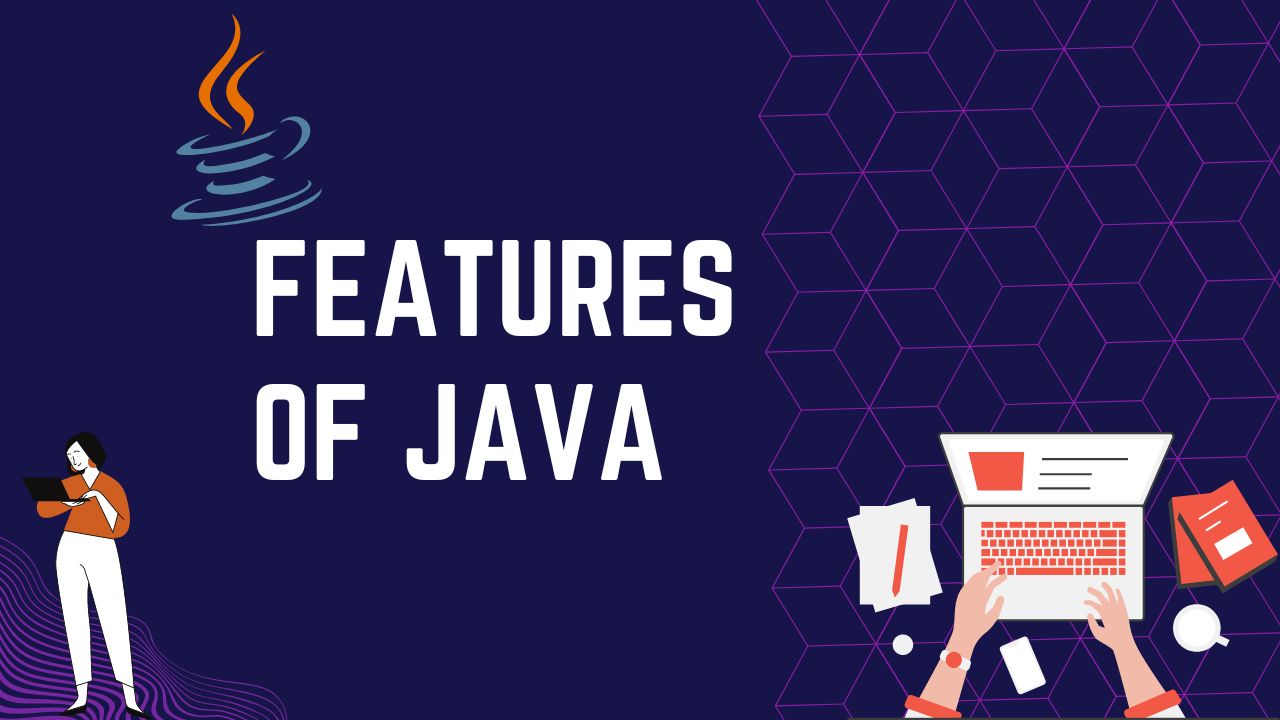
 Logicmojo - Updated Jan 2, 2025
Logicmojo - Updated Jan 2, 2025
Introduction
Sun Microsystems initially introduced Java, a programming language and a computing platform, in May 1995 under the guidance of James Gosling. It was later undertaken by Oracle Corporation. James Gosling is known as the Father of Java. It has grown from its modest origins to power a significant portion of the present digital world by offering the solid foundation upon which numerous services and applications are developed. We are aware of Java's significant position in the world of coding. Many programmers prefer Java over other computer languages. But Why? The amazing features offered by Java is the main reason for this. Let's take a closer look at what these features are further in this article.
Primary Features of Java
Let us have a look into what are the main features of java which makes it unique from other languages.
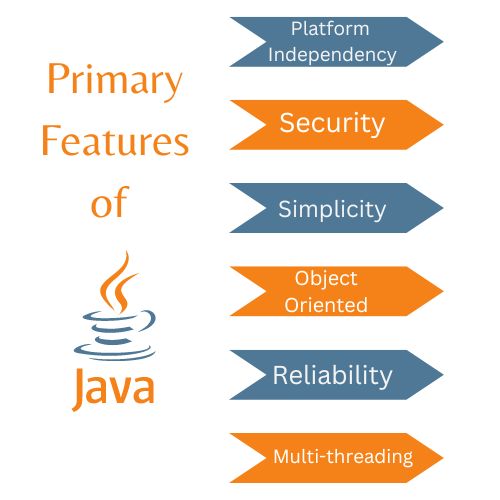
Platform Independency
A software or a language is said to be platform independent if it can adapt to various hardware or software architectures.
Java offers this feature by converting the source codes into bytecodes using a compiler. These bytecodes can be executed on any platform (Windows,Mac or Linux), with the help of the Java Virtual Machine(JVM). Hence, Java is called as a Platform Independent Language.
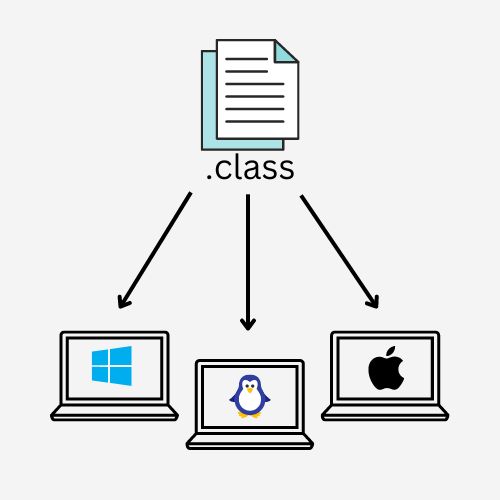
Secure
Java is a very secure language as it runs the programs inside a sandboxed virtual machine. It offers a high level security using many inbuilt features like:
⮞Bytecode Verifier: This checks the code for violations of access rights to other objects.
⮞Security Manager: The resources valid for class to access, is determined by the security manager.
⮞Classloader: This feature enables the loading of java classes into the JVM dynamically. It comes under the Java Runtime Environment or commonly called as the JRE. It also classifies the package for the classes as "imported from other sources of network" and "present in the local machine's file system".
It has no concept of pointers. It helps to build a system which is free of virus. Some security features can also be added explicitly using application developer like JAAS, SSL, etc.
Simple Appraoch
Java has a simple approach towards coding.
⮞It refrains from using complex elements such as operator overloading, allocation of memory explicitly, multiple inheritances, etc.
⮞It is also considered to be an easy-to-learn and easy-to-understand language because of the clear syntactical approach of the code.
⮞It also offers Automated Garbage collection which helps to free up unused space dynamically.
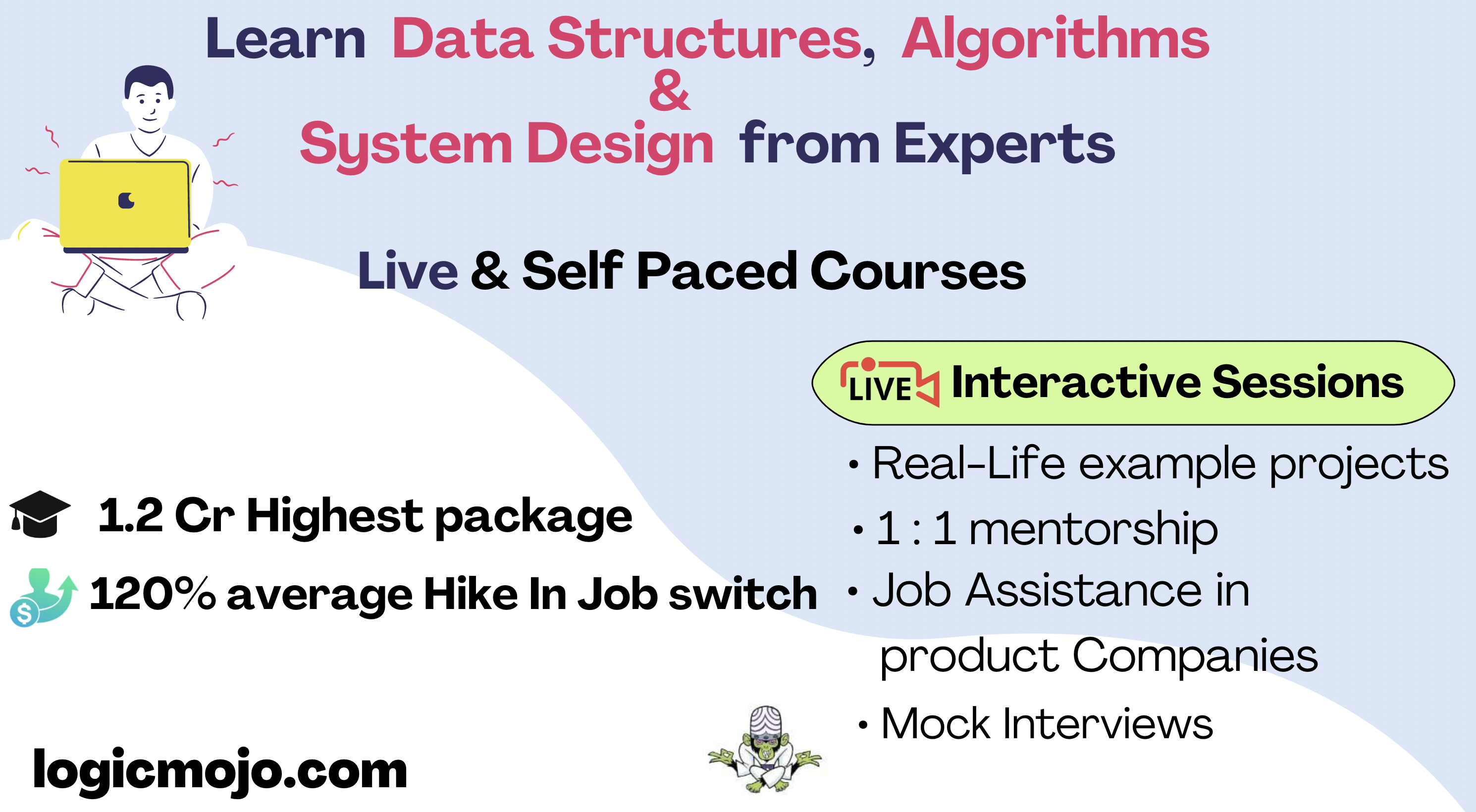
Object Oriented approach
Java is an Object Oriented Concepts based Programming language. It is built using classes and objects. Object oriented programming is a coding concept which simplifies the development of software with the help of a bottom-up approach. The four main pillars of Object Oriented Programming which are also offered by Java are:
⮞Inheritance: It is a feature in which the properties of one class is inherited or acquired to another class.
⮞Abstraction: It is a feature in which the some details of a class is hidden and only the requierd information is shown to the user
⮞Polymorphism: It is a feature in which more than one classes are related to one another with the concept of arguments, parameters or inheritance.
⮞Encapsulation: It is a feature in which the variables and the functions that includes these variables are bounded into a single package called as class.
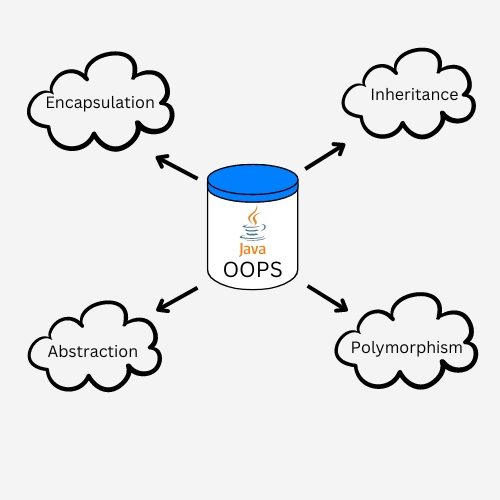
Reliable
Java is a programming language which is robust. It is a powerful and dependable language. Because of the Java compiler's design, which places a high priority on error detection as soon as feasible, errors that are challenging to discover in other programming languages can be found.
⮞Garbage collection
⮞Exception handling
⮞Memory allocation are the three main characteristics of Java that provide robustness or reliability.
Multithreading
The word multithreading means many threads processed at the same time. Threads are small sub-tasks or sub-processes under a single process. Java allows the parallel processing of more than one part of program(thread) at a given instance of time. This is achieved with the help of two mechanisms used to create a thread.
⮞Extension of a class called 'Thread'
⮞Implementation of the runnable interface
class DemoThread extends Thread { public void run() { try { //To show which that the current thread is being implemented System.out.println( "Thread " + Thread.currentThread().getId() + " is being implemented"; } catch (Exception e) { // Throws an exception System.out.println("Exception error"); } } } class Multithreads{ public static void main(String[] args) { int n = 10; for (int i = 0; i < n; i++) { Thread obj = new Thread(new DemoThread()); obj.start(); } } }
The purpose of Multi-threading is to utilise the CPU to its optimum.
Other features of Java
Distributed Applications
You may create a variety of applications using Java. It enables you to run those programmes as small modules on a single machine or several devices.
Distributing Java programmes among one or more systems that are connected to one another over the internet is simple.
This is accomplished via Remote Method Invocation and Enterprise Javabeans.
Flexibility
Due to the fact that Java is entirely object-oriented, we have the freedom to add classes, new methods to existing classes, and even create brand-new classes. This can be done through sub classes. Java even allows native methods, which are functions created in languages other than Java, such as C and C++. Thus, Java offers flexibility to the user.
Compilation and Interpretation
Java provides an integration of compilation and interpretation. This makes it more powerful compared to other programming languages which provide either interpretation or compilation. The compilation is taken care by the Java Compiler whereas the JVM performs the function of the interpreter.
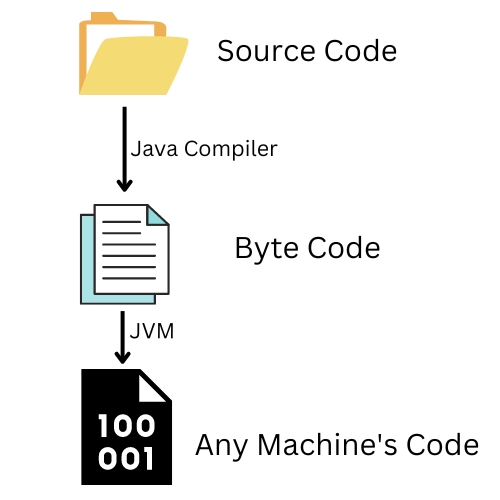
Portable
The platform independency feature of Java makes it easy to port from one device to another. The byte-code can be transferred to any device or platform. The Java Compiler is built using the ANSI C which enables effective portability
Write Once Run Anywhere
Also known as WORA, this feature of Java provides easy access to bytecode as it is machine-architecture independent. The code is stored in a .class file which has the code in the form of binary language.
Difference Between Java and C++
| Java | C++ |
|---|---|
| Platform Independent | Platform Dependent |
| Supports comments for documentation purpose | Does not support comments for documentation purpose |
| Automatic Memory Management | Memory has to managed manually |
| Purely based on Object oriented programming | Has features of Object Oriented approach |
Versions of Java
The most recent Java version with ongoing support is Java 17(LTS). It's crucial to remember that many applications are still built using Java 8 and Java 11 in 2022. Although Java 17 offers LTS, it's not unusual for applications to use Java 11 or even Java 8. Three versions with LTS are now available (8, 11, and now 17). Here, LTS means Long Time Support.
Features of Java 8
Some of the noteworthy features provided by Java 8 are as follows
Stream API
To process object collections, one can utilise the Stream API. A stream is a collection of objects, in sequence, that can support several operations and be pipelined to create the desired outcome. Note that stream is not a data structure. It can be executed only when the requirement arises.
Security Enhancements
Some of the security Enhancements are:
-> With the addition of the "AccessController.doPrivileged" method, code can now affirm a part of its privileges without blocking the entire stack-traversal to check for other rights.
->The SunJCE provider includes the Advanced Encryption Standard (AES) algorithm and some Password-Based Encryption (PBE) algorithms like PBEWithSHA256AndAES_128 and PBEWithSHA512AndAES_256.
->The keytool utility has a new command flag named -importpassword. It is utilised to recognise passwords and safely store them as secret keys.
->For the creation of public keys private keys or ciphertexts, the SecureRandom class offers the generation of cryptographically robust random integers.
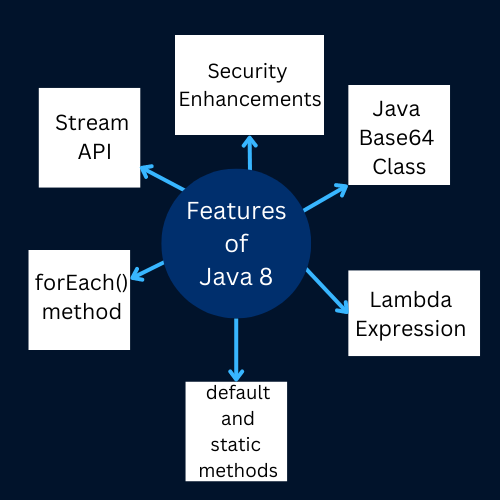
Java Base64 Class
The Base64 class provided by Java is used while decryption or encryption. It can be accessed by importing the java.util.Base64 class in the source file. Three unique decoders and encoders are provided by this class to work at different levels of cryptography.
Lambda Expression
The lambda expression facilitates the functional design of our code. It offers a simple and direct method for implementing the SAM interface (Single Abstract Method) through the use of an expression. It is highly helpful for iterating, filtering, and extracting data in collection libraries.
forEach() method in Iterable interface
The forEach function in java.lang was added in Java 8. Iterable interface allows us to concentrate on business logic while writing code. Java.util.function is a parameter for the forEach method. Having our business logic in a different area that we can reuse helps since we can use a consumer object as an argument.
Default and static methods in Interfaces
Java 8 improves interfaces by adding a method and implementation. To design interfaces with method implementation, we can utilise the static and default keyword.
Features of Java 11
Java 11 has some cool additions in its features.
New String methods
Some methods like isblank, strip, repeat, lines, stripTrailing, stripLeading are added to Java 11.
These methods can eliminate the need to import libraries and cut down on the boilerplate necessary in managing string objects.
When it comes to the strip methods, they offer functionality that is comparable to the more well-known trim method but with better control and Unicode support.
There is a new default toArray method that accepts an IntFunction parameter in the java.util.Collection interface.
This makes constructing the appropriate type of array from a collection simpler
New File methods
Reading and writing Strings from files is much simpler. The Files class's new readString and writeString static methods are available to us.
Path fPath = Files.writeString(Files.createTempFile(tempDir, "Hello", ".txt"), "Hello World"); String fContent = Files.readString(fPath); assertThat(fContent).isEqualTo("Hello World");
No-Op Garbage Collector
Java 11 has an experimental feature named Epsilon, a brand-new garbage collector. It allots RAM without actually collecting any trash,. Hence, it is referred to as a No-Op (No Operations). Thus, Epsilon can be used to simulate out-of-memory issues.
Java Flight Recorder
JFR or Java Flight Recorder is a tool, specifically a profiling tool, used to collect diagnostic and profiling information from a java program which is running. This tool used to be a product for commercials purposes in Oracle JDK. But, Java 11 makes it available as a open-source in a JDK called Open JDK.
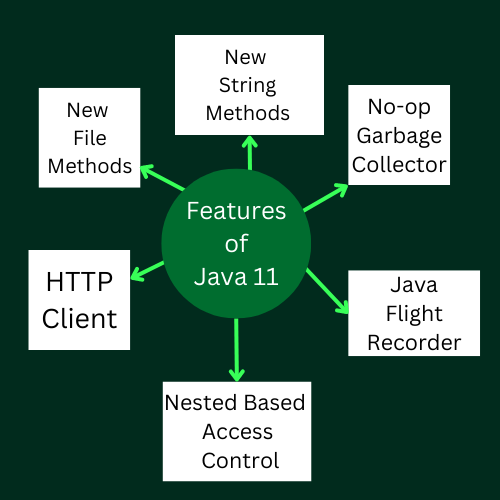
Nested Based Access Control
public class Main { public void PublicMethod() { } private void PrivateMethod() { } class Nested { public void PublicNested() { PrivateMethod(); } } }
In the manner shown above, the above-nested class can access private methods of the main class. However, if Java Reflection is used, an IllegalStateException will be generated.
HTTP Client
The Http CLient API is standardised in Java 11. HTTP/1.1 and HTTP/2 are both supported by the new API. It is intended to enhance how quickly a client can send requests and how quickly a server can respond to those requests. WebSockets are also natively supported.
Features of Java 17
Java 17 is the Last "Long Term Support" (LTS) version of Java released in September, 2021. Take a look at some advanced features of this latest version.
Foreign Function and Memory API
Java programmers can access code from outside the JVM and control memory outside of the heap thanks to the Foreign Function and Memory API. The intention is to replace the Java Native Interface API and enhance its performance and security over the previous version.
Enhanced PRNG
New implementations and interfaces for Pseudo-Random Number Generators is provided in The JDK Enhancement Proposal or The JEP 356. This makes it easier for the usage of various algorithms alternatively. A greater support for programming based on Streams is also provided.
Encapsulation of JDK Internals
JEP 403 eliminates the flag -illegal-access. This signals another step toward strongly isolating JDK internals. If the flag is present, the console will send out a message asking the platform to stop using the flag, and the platform will disregard the flag. Except for essential APIs like sun.misc.Unsafe , this feature will block JDK users from accessing internal APIs.
Sealed Classes
A new feature is introduced to the language through JEP 409. This feature is called as the Sealed Classes. Sealed Classes comes under The Project Amber. This was available as a preview in the JDK versions 15 and 16.
A sealed component's ability to be extended or implemented by other classes or interfaces is constrained by this feature. Combining the JEP 406 with another pattern matching advancement will provide a more complex and clean inspection of the type, act code pattern and cast.A sealed component's ability to be extended or implemented by other classes or interfaces is constrained by this feature. Combining the JEP 406 with another pattern matching advancement will provide a more complex and clean inspection of the type, cast, and act code pattern.
Upcoming Java Versions
Java releases new versions every 6 to 7 months. This leads to an expectation of the future release The Java 20 in March 2023 and further the release of Java 21 is expected in September 2023.
Conclusion
This concludes our discussion of "Features in Java." I sincerely hope that you learned about some exciting features of java and are now more interested to dive into the language. You can consult the Java Tutorial for further guidance.
Good luck and happy learning!
